Haeger Flower Frogs
David Haeger grew his company from a brickyard he purchased in 1871, and it remained in operation through 2016. But it was his son, Edmund Haeger, who introduced Haeger art pottery in 1914. Since that time Haeger pieces have reflected art movements ranging from Arts & Crafts to Art Deco to Mid-Century Modern and beyond. Many pieces might be viewed as caricatures of these movements, very outspoken and fun to collect!
Martin Stangl left Fulper Pottery and came to work for Haeger in 1914, and was influential in the design and success of Haeger's art pottery line. He left Haeger when he purchased Fulper in 1924.
The name "Royal" was affixed to the name of most art pottery pieces beginning after Royal Hickman started design work for Haeger in 1939. Numbers for pieces produced under the name of "Royal Haeger" were given the prefix R, e.g., R-360 Tropical Fish Flower Block.
Definition of Flower Frog: I only collect pieces with holes extending through their bottoms that were designed to sit in water. It's how flower frogs got their name! However, many collectors use a much broader definition, so I have included vases with multiple holes designed to hold flower stems.

Impressed Logo and Red Clay: Pieces that have an impressed Haeger diamond logo on the bottom, and/or were made with red clay, are among the earliest pieces of Haeger art pottery with production beginning in 1914.
Glazes: There are a gazillion Haeger glazes and many collectors enjoy identifying them. Catalogs often list the glazes available for particular pieces; other times they simply list the glazes available for the items appearing in the catalog.
However, many of the early glaze descriptions are ambiguous. And many could have been described in catalogs that have never been found, so we have to be careful not to mismatch them to known glazes. And finally, they were all applied by hand so we never see two pieces alike.
I give the name of the glaze for each piece I feel somewhat confident about, but it is never more than a best guess.
To see a list of Haeger glazes with examples, visit the Haeger Glaze Gallery on HaegerAshtrays.com.
Names: From one catalog to another Haeger was often inconsistent in naming its pieces, and some were only given a number. I have assigned a brief name to each piece that I think best identifies it.
Aliases: In some cases the various names given to a piece vary so greatly that one might not realize they are the same piece. In these cases, I have listed aliases.
Sources: When I have been able to find a piece in a catalog, I list the catalog(s) along with the piece. When I have only been able to find a piece in a book, I list the book by a brief title in italics. For more information on the books please see Identification Resources.
[1] Available in the Royal Haeger Pottery Collectors Facebook group
[2] Available in the Haeger Pottery Enthusiasts Facebook group
Credits: Credits for photos and textual content appear in brackets. [web] indicates a photo made available by an online seller.
Peter Christensen
Peter@MyFlowerFrogs.com
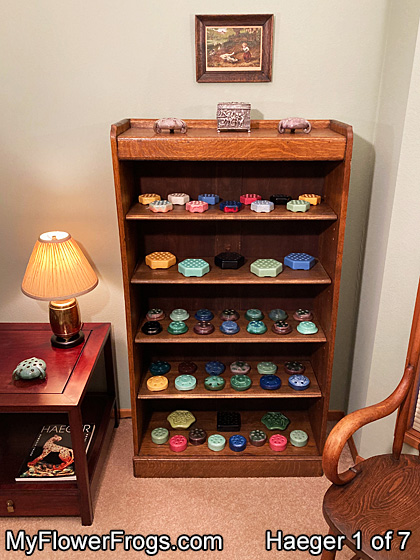
From my personal collection [Peter Christensen]
Click to enlarge
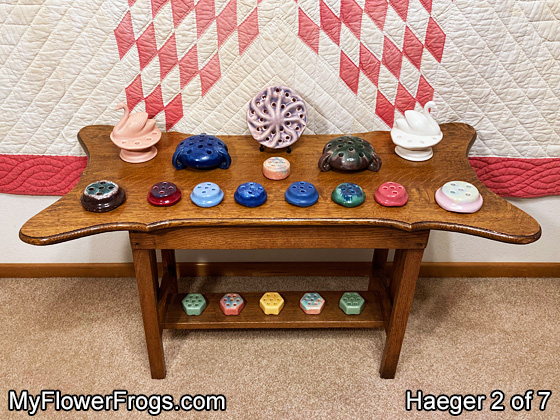


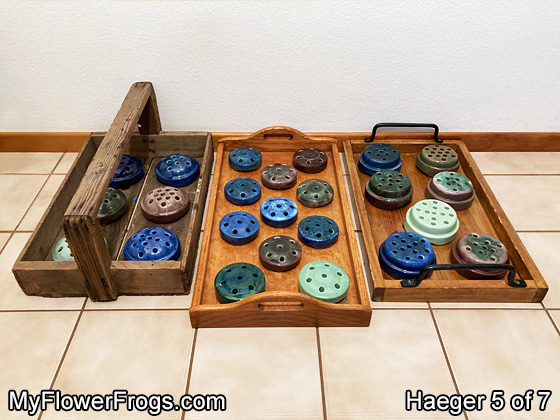
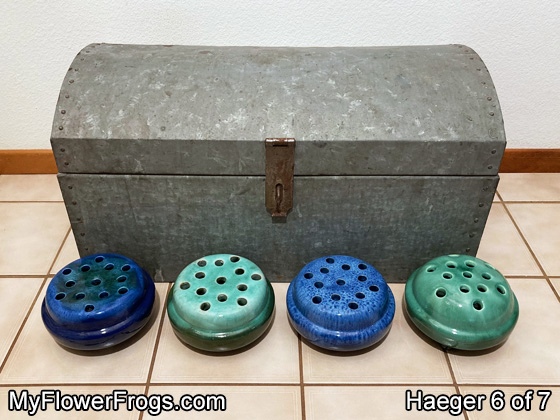
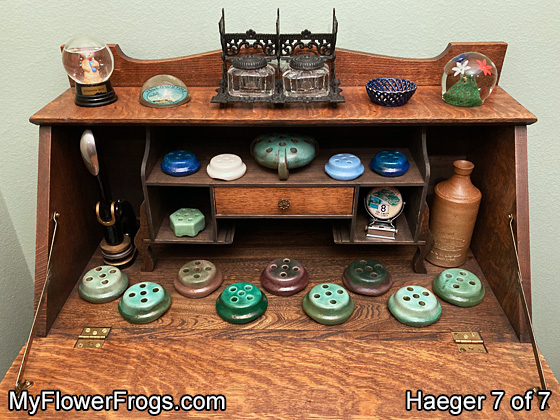
Haeger Flower Frogs
Number Unknown
Regular Haeger
- No. 6 Hexagonal (2")
- No. 7 Hexagonal (3")
- No. 8 Round (3")
- No. 9 Round (3")
- No. 10 Round (5")
- No. 10 Hexagonal (4")
- No. 11 Round (4")
- No. 14 Round (2½")
- No. 53 Round (4")
- No. 54 Round (4")
- No. 55 Round (6")
- No. 56 Round (6")
- No. 57 Swan
- No. 58 Lily Pad
- No. 59 Round
- No. 77 Nymph
- No. 86 Mermaid with Child
- No. 264 Dancer - Scarf Above
- No. 270 Two Dancers
- No. 271-A Dancer - Short Base
- No. 271-B Dancer - Tall Base
- No. 273 Three Dancers
- No. 3234 Bulb
- No. 3235 Dome
- No. 3245 Dome
Flower-ware
Royal Haeger
- R-104 Deer
- R-125 Sea Gull
- R-157-B Three Diving Sharks
- R-169-B Leaping Trout
- R-189 Seated Nude
- R-218-B Giraffes
- R-316 Three Birds
- R-333-B Shrouded Woman
- R-359 Two Birds
- R-360 Tropical Fish
- R-361 Three Birds on Branch
- R-362 Pan
- R-363 Nude on Fish
- R-364 Nude with Seal
- R-514 Dolphin
- R-619 Nude
- R-672 Mongolian Man
- R-673 Mongolian Woman
- R-710 Square
- R-730 Fruits & Leaves
- R-761 Hexagonal
- R-772 Stag
- R-788 Jockey on Race Horse
- R-813 Round
- R-820 Bird
- R-836 Sitting Frog
- R-837 Laying Frog
- R-838 Turning Frog
- R-977 Shell
Clam Shell
Sources: I have not found this piece in any Haeger catalog or book. The only reference I have found is in the 1927 newspaper ad, below.

Mauve Agate glaze [Susan Mathews]
Additional Examples
Click to enlarge and read annotation


Fish
Sources: This fish appears in The House of Haeger 1914-1944, page 81. It is listed as part of set E-100, which includes bowl No. 100.

Geranium Leaf Green glaze [Randall Stanek]
Additional Examples
Click to enlarge and read annotation

Frog
Sources: I have not found this piece in any Haeger catalog or book. However, this frog appears on several other Haeger pieces.

[Susan Mathews]
Lady and Fawn
Sources: The House of Haeger 1944-1969

Green Agate glaze [Randall Stanek]

[Annie Liner]
Sea Star
Aliases: Often referred to as Octopus, though it has 9 legs and an octopus has 8.
Sources: I have not found this piece in any Haeger catalog or book.
Sizes: In the below photo the pieces on the left and right have a 5½" diameter. While the center piece appears to be bigger, it has a 5" diameter. Also, a collector has reported acquiring a piece with a 4" diameter that came with a 505b/8" bowl.

1st row: both unidentified
2nd row: unidentified, Geranium Leaf Green
Additional views and measurements of the above examples may be found here.
[Peter Christensen]
Additional Examples
Click to enlarge and read annotation
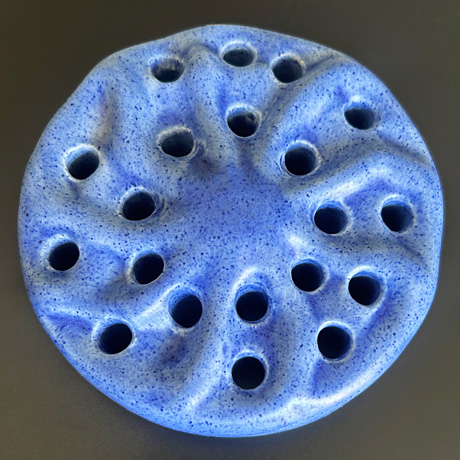



No. 6 Hexagonal (2")
Notes: Prior to December 12, 1924, No. 6 was assigned to a bowl.
Sources: I have not found this piece in any Haeger catalog or book.
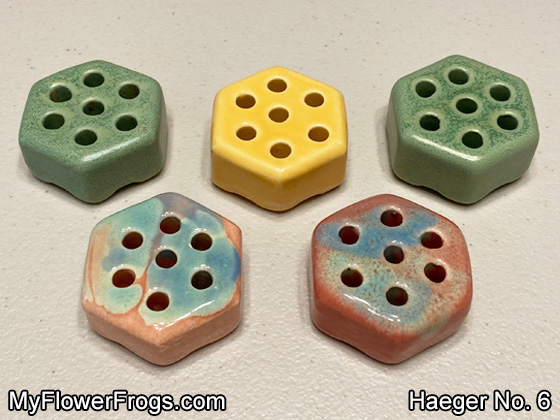
1st row: Italian Yellow, and Blue and Red Flambé
2nd row: Geranium Leaf Green
3rd row: Peach Agate
Additional views and measurements of the above examples may be found here.
[Peter Christensen]
No. 7 Hexagonal (3")
Notes: Prior to December 12, 1924, No. 7 was assigned to a bowl.
Sources: I have not found this piece in any Haeger catalog or book.
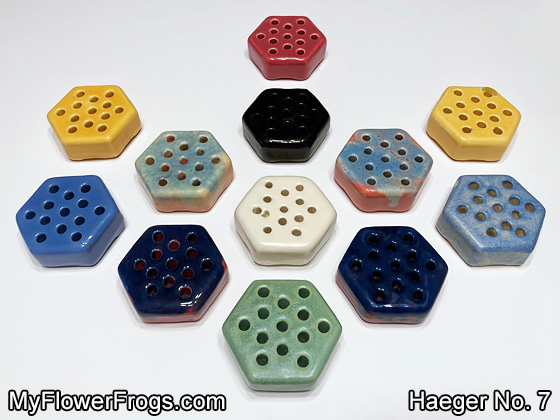
1st row: Geranium Leaf Green
2nd row: Blue and Red Flambé (both)
3rd row: unidentified, Ivory, and unidentified
4th row: Peach Agate (both)
5th row: Italian Yellow, Black, and Italian Yellow
6th row: Rose
Note that the Black example is the earlier glaze described in the 1922 Catalog as "a deep blue-black" that shows blue highlights, and not the Ebony glaze described in later catalogs.
Additional views and measurements of the above examples may be found here.
[Peter Christensen]
Additional Examples
Click to enlarge and read annotation

No. 8 Round (3")
Sources: 1922 Catalog [1], Early Catalog Number 17 [1]

1st row: Black, Mulberry and Green Flambé (2), Mere Green, Mauve Agate, Blue of Sky Flambé, and Green and Agate Blue Flambé
2nd row: Blue and Green Flambé, Green and Agate Blue Flambé, Catseye (2), and Cats Eye (2)
3rd row: Cats Eye (4), and Mulberry and Green Flambé
4th row: Mulberry and Green Flambé (4)
5th row: Mulberry and Green Flambé, Geranium Leaf Green, and Mulberry and Green Flambé
Note that the Cats Eye (two words) examples are the earlier glaze described in the 1922 Catalog, and the Catseye (one word) examples are the latter glaze described in the 1949 Spring Catalog.
Also, the Black example is the earlier glaze described in the 1922 Catalog as "a deep blue-black" that shows blue highlights, and not the Ebony glaze described in later catalogs.
Additional views and measurements of the above examples may be found here.
[Peter Christensen]
Additional Examples
Click to enlarge and read annotation



No. 9 Round (3")
Identification: Note the plateau around the center hole.
Sources: 1922 Catalog [1], Early Catalog Number 17 [1]

1st row: Italian Yellow, Mere Green, Geranium Leaf Green (sans mottling), Cats Eye, and Blue of Sky Flambé
2nd row: Mulberry and Green Flambé, Blue of Sky Flambé, Blue and Green Flambé, and Green Agate
3rd row: Catseye, Green and Agate Blue Flambé, Mulberry and Green Flambé (2), and Blue of Sky Flambé
4th row: Mulberry and Green Flambé (3), and Blue of Sky Flambé
5th row: Green Agate, Blue and Green Flambé, Mulberry, Blue and Green Flambé, and Geranium Leaf Green
Note that the Cats Eye (two words) example is the earlier glaze described in the 1922 Catalog, and the Catseye (one word) example is the latter glaze described in the 1949 Spring Catalog.
Additional views and measurements of the above examples may be found here.
[Peter Christensen]
Additional Examples
Click to enlarge and read annotation


No. 10 Round (5")
Notes: According to Martin Stangl's notebook, after December 12, 1924, No. 10 was reassigned to Hexagonal (4"), below. [Peter Meissner]
Sources: Early Catalog Number 17 [1]
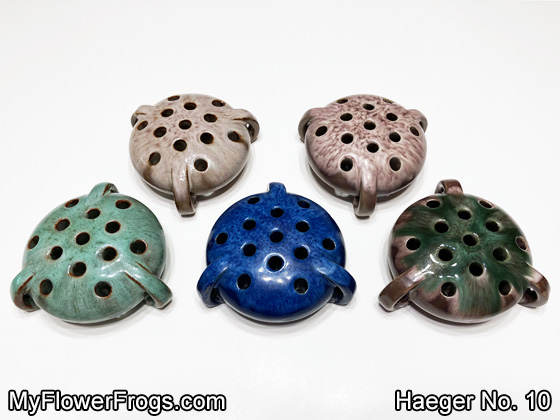
1st row: Catseye, Blue of Sky Flambé, and Mulberry and Green Flambé
2nd row: unidentified (both)
Additional views and measurements of the above examples may be found here.
[Peter Christensen]
Additional Examples
Click to enlarge and read annotation


No. 10 Hexagonal (4")
Notes: According to Martin Stangl's notebook, prior to December 12, 1924, No. 10 was assigned to Round (5"), above. [Peter Meissner]
Sources: I have not found this piece in any Haeger catalog or book. The only reference I have found is in the 1926 newspaper ad, below.
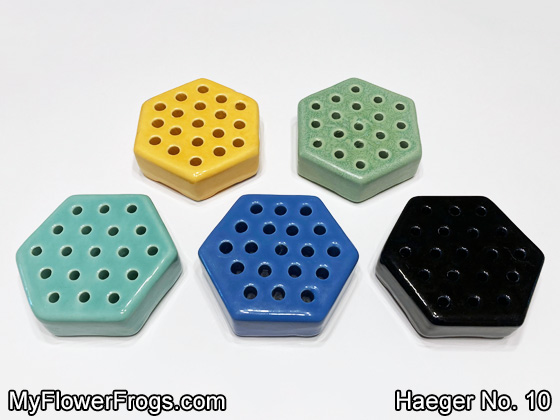
1st row: Mere Green, unidentified, and Black
2nd row: Italian Yellow, and Geranium Leaf Green
Note that the Black example is the earlier glaze described in the 1922 Catalog as "a deep blue-black" that shows blue highlights, and not the Ebony glaze described in later catalogs.
Additional views and measurements of the above examples may be found here.
[Peter Christensen]
Additional Examples
Click to enlarge and read annotation


No. 11 Round (4")
Sources: 1922 Catalog [1], Early Catalog Number 17 [1]
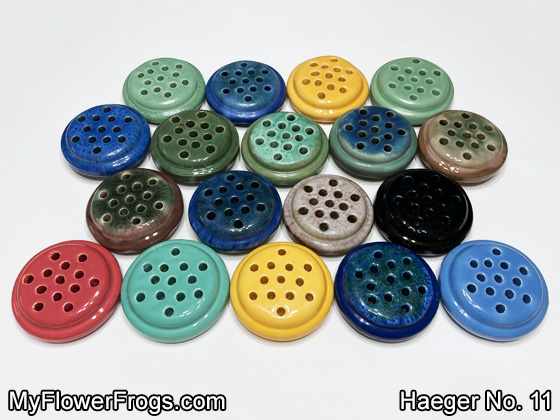
1st row: Rose, Mere Green, Italian Yellow, Blue and Green Flambé, and French Blue
2nd row: Mulberry and Green Flambé, Blue and Green Flambé, unidentified, and Black
3rd row: Blue of Sky Flambé, Green, Green Flambé, Green and Agate Blue Flambé, and Mulberry and Green Flambé
4th row: Geranium Leaf Green, Blue and Green Flambé, Italian Yellow, and Geranium Leaf Green (sans mottling)
Note that the Black example is the earlier glaze described in the 1922 Catalog as "a deep blue-black" that shows blue highlights, and not the Ebony glaze described in later catalogs.
Additional views and measurements of the above examples may be found here.
[Peter Christensen]
Additional Examples
Click to enlarge and read annotation




No. 14 Round (2½")
Sources: 1922 Catalog [1], Early Catalog Number 17 [1]
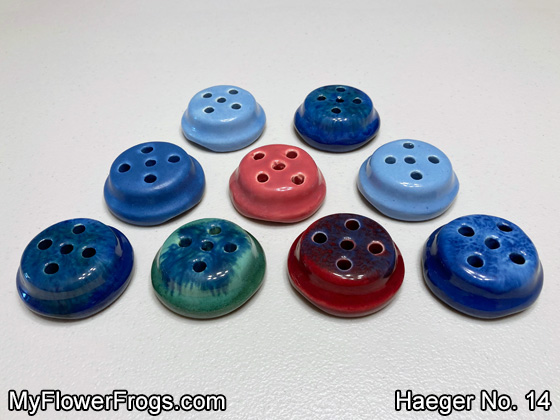
1st row: Blue and Green Flambé, Green and Agate Blue Flambé, Blue and Red Flambé, and Blue of Sky Flambé
2nd row: unidentified, Rose, and French Blue
3rd row: French Blue, and Blue and Green Flambé
Additional views and measurements of the above examples may be found here.
[Peter Christensen]
No. 53 Round (4")
Sources: 1922 Catalog [1], Early Catalog Number 17 [1]
Variations: Note that the number of holes varies.

1st row: Green, Geranium Leaf Green, and Mulberry and Green Flambé
2nd row: Mulberry and Green Flambé, Blue and Green Flambé, Blue and Green Flambé, and Mulberry and Green Flambé
Additional views and measurements of the above examples may be found here.
[Peter Christensen]
Additional Examples
Click to enlarge and read annotation

No. 54 Round (4")
Sources: 1922 Catalog [1], Early Catalog Number 17 [1]
Variations: Note that the number of holes varies.
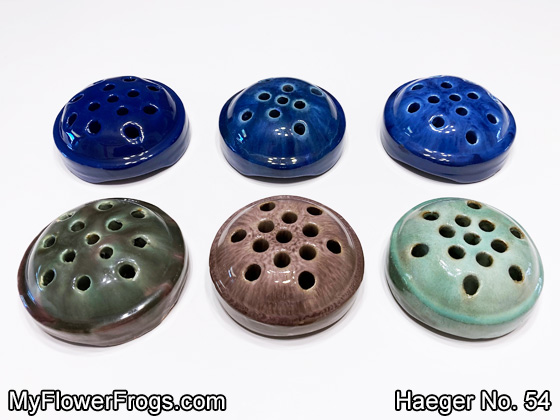
1st row: Mulberry and Green Flambé, unidentified, and Cats Eye
2nd row: Chinese Blue, Blue and Green Flambé, and Blue of Sky Flambé
Additional views and measurements of the above examples may be found here.
[Peter Christensen]
Additional Examples
Click to enlarge and read annotation


No. 55 Round (6")
Sources: Early Catalog Number 17 [1]
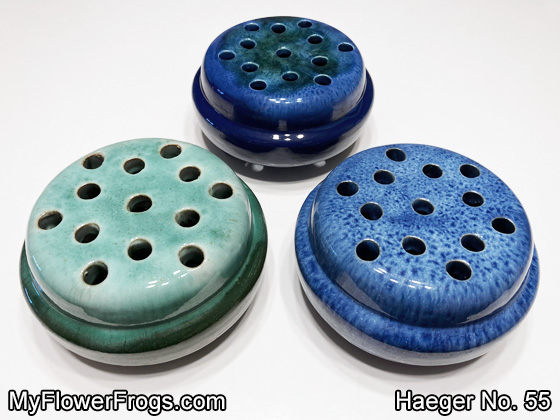
Left: Blue of Sky Flambé
Center: Cats Eye
Right: Blue and Green Flambé
Additional views and measurements of the above examples may be found here.
[Peter Christensen]
Additional Examples
Click to enlarge and read annotation





No. 56 Round (6")
Sources: Early Catalog Number 17 [1]
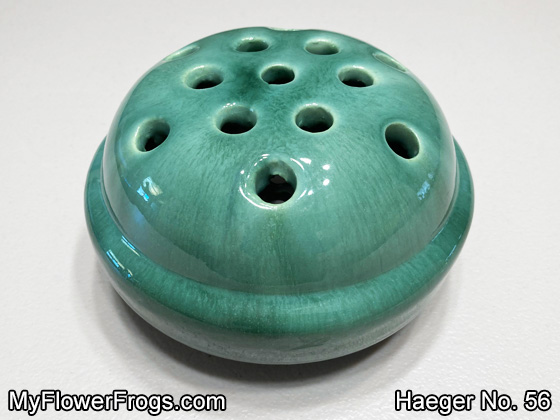
Left to right: Mulberry and Green Flambé, and Catseye
Additional views and measurements of the above examples may be found here.
[Peter Christensen]
No. 57 Swan

1st row – Parted Wings shape: gloss White and Italian Yellow (one on right has speckles)
2nd row – Semi-Parted Wings shape: gloss White and matte Chinese Blue, gloss White and Mere Green, gloss White and Geranium Leaf Green, and semi-gloss Ivory
3rd & 4th rows – Closed Wings shape: matte Coral, simi-gloss White, and gloss Yellow
Additional views and measurements of the above examples may be found here.
[Peter Christensen]
Three Distinct Shapes
I call the shapes Parted Wings, Semi-Parted Wings, and Closed Wings because if you own a swan or have a photo taken from above it's the most obvious distinction between them. However, you can also distinguish the difference from just about any photo if you know what to look for.

Early Catalog No. 17
Sources: I have found the swan in the 1922 Catalog [1], Early Brochure [1], Early Catalog Number 17 [1], 1930 Catalog [1], 1939 Fall Catalog [1], and 1940 Catalog Number 110 [1].
Early Catalog Number 17 clearly pictures the Parted Wings shape, and the 1940 Catalog Number 110 clearly pictures the Closed Wings shape. In the 1922 Catalog and Early Brochure, I can't distinguish between the Parted and Semi-Parted Wings shapes, but the illustrations are clearly not of the latter Closed Wings shape.
The illustration in the 1930 Catalog is an anomaly. It clearly shows parted wings, and yet shows 4 holes per side as is found on the Closed Wings shape. The holes are badly misplaced, and I suspect they were created by the illustrator. Perhaps this illustration represents a transition to the Closed Wings shape.

Parted Wings Shape: Wings fully parted; rounded tail turns up; deep notch in lily pad; 6 holes

Semi-Parted Wings Shape: Wings part behind neck; cone-shaped tail; notch in lily pad; 6 holes

Closed Wings Shape: Wings fully closed; cone-shaped tail; no notch in lily pad; 8 holes

Parted Wings Shape: Curved beneath down-turned head; two sets of feathers in wings; narrow, up-turned tail

Semi-Parted Wings Shape: Curved beneath down-turned head; two sets of feathers in wings; cone-shaped tail

Closed Wings Shape: Straight and horizontal beneath head; one set of feathers in wings; cone-shaped tail

Parted Wings Shape: Bottom solid

Semi-Parted Wings Shape: Bottom open

Closed Wings Shape: Bottom partially closed
And finally, overall size and height vary too, with the oldest shape being the smallest and the newest being the largest.

Parted Wings, Semi-Parted Wings, and Closed Wings Shapes
Additional Examples
Parted Wings Shape
Click to enlarge and read annotation



Semi-Parted Wings Shape
Click to enlarge and read annotation




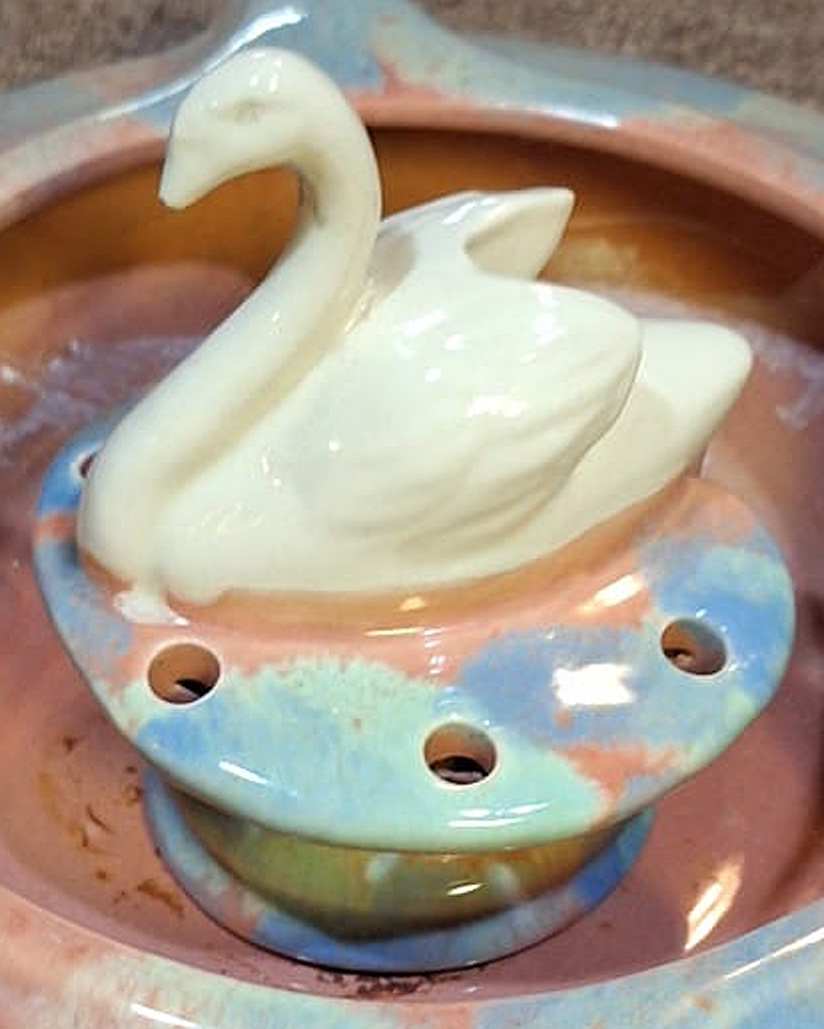

Closed Wings Shape
Click to enlarge and read annotation


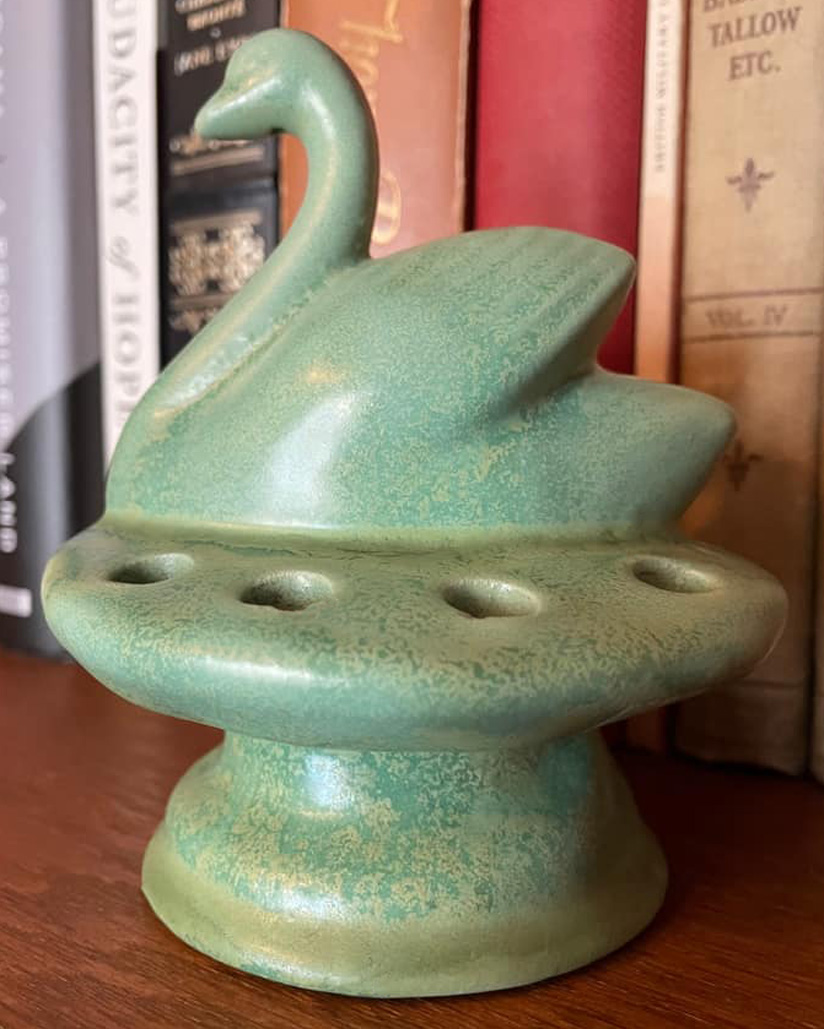
Other Manufacturer's
for Comparison
Click to enlarge and read annotation


April Fool's 2024
as Posted on Facebook

Haeger Swan No. 57
Strawberries & Cream Glaze
I was thrilled to recently acquire this example of one of the rarest of all Haeger glazes. Yes, there were one-of-a-kind experimental glazes. But this was an actual production run, albeit believed to be a trial run of only around a half-dozen and sold only in the factory showroom briefly in 1930.
It was almost immediately dubbed the "Chicken Pox glaze" by snickering showroom staff, and didn't sell well. As Margaret Walsh humorously writes in Glazes of the American Art Potteries:
"Strawberries and Cream was one of four glazes designed for the explicit purpose of attracting a younger, less sophisticated buyer to Haeger art pottery. And that it did! According to Karen Thornson, long-time clerk in Haeger's factory showroom, the only two examples sold were 'purchased by mothers with children in tow.'"
Only two examples are known to exist today. The one documented in Margaret Walsh's book, and the one I bought in a thrift shop in Battle Ground, WA, for $5. It is not known if those that didn't sell to the public were sold to employees for a token price, or simply destroyed. If they were destroyed, we owe the existence of the two that survived to the children who saw them in the factory showroom.
April Fool's 2021
as Posted on Facebook

Haeger Swan No. 57
Ultra Rare Factory Production Error
Auction
The only known Haeger piece to have survived the manufacturing error of the mold being upside-down. Bidding starts April 2nd.
No. 58 Lily Pad
Aliases: Leaf, Green
Sources: 1922 Catalog [1], Early Catalog Number 17 [1]
Variations: Note that the number of holes varies.

Mulberry and Green Flambé glaze
Additional views and measurements of the above examples may be found here.
[Peter Christensen]
Additional Examples
Click to enlarge and read annotation




No. 59 Round
Identification: Unless you know Haeger glazes well, this is an extremely difficult piece to collect because it has to be identified among a gazillion similar flower frogs. And even then, some of the solid-colored glazes are very much like those you see on flower frogs made in Japan. Most examples I have seen in Haeger collections were accompanying matching bowls.
Characteristics to look for other than a Haeger glaze are the indented ring around the perimeter of the top, the shape of the bottom, and a ring halfway down the side that runs around the perimeter. I suspect this formed at the joining of the halves of a clamshell-shaped mold.
Sources: 1922 Catalog [1], Early Catalog Number 17 [1]
Variations: Note that the size and number of holes varies. The larger sizes have 8 holes; the smaller sizes have 7 holes. (The perspective of the below photo is misleading in terms of size. Additional views and measurements may be found here.

1st row: Blue and Green Flambé, Peach Agate, Geranium Leaf Green, and Blue of Sky Flambé
2nd row: Geranium Leaf Green and Rose
3rd row: Mulberry and Green Flambé
4th row: Mere Green
Additional views and measurements of the above examples may be found here.
[Peter Christensen]
Additional Examples
Click to enlarge and read annotation




No. 77 Nymph
Aliases: Nude or Seated Nude
Sources: 1922 Catalog [1]
Variations: Note that the number of holes varies.
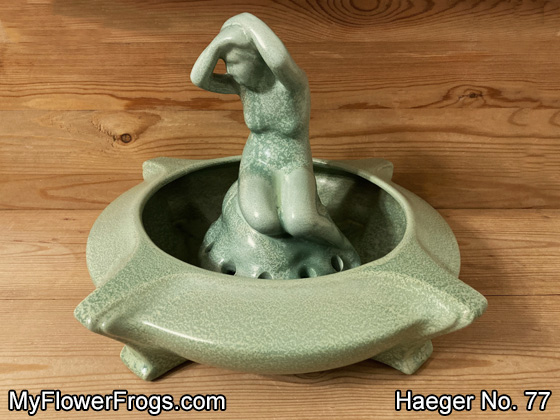
Geranium Leaf Green glaze
Additional views and measurements of the above examples may be found here.
[Peter Christensen]
Additional Examples
Click to enlarge and read annotation
















Yankoware Japan
for Comparison
Click to enlarge and read annotation


No. 86 Mermaid with Child
Aliases: Sea Nymph
Sources: 1922 Catalog [1]
Variations: Note that in some of the examples the tail of the baby hangs apart from the mother. It often broke off and was redesigned to rest on the mother's stomach.

[Matthew Charles]

[quinnsfinest on eBay]
Additional Examples
Click to enlarge and read annotation
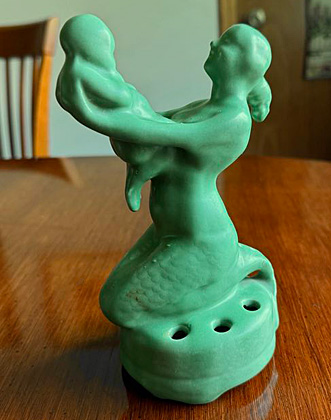


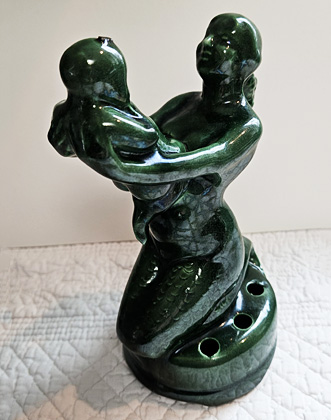
No. 264 Dancer - Scarf Above
Sources: Early Brochure [1]

Ivory glaze [Annie Liner]
No. 270 Two Dancers
Sources: 1928 Price List [1], Early Brochure [1]

Soft Matte Cream glaze [Joyce Donahue]
No. 271-A Dancer - Short Base
Sources: 1928 Price List [1], Early Brochure [1], and the 1927 newspaper ad, below

[1928 Price List]
Click to enlarge and read annotation

No. 271-B Dancer - Tall Base
Sources: 1928 Price List [1]

[1928 Price List]
No. 273 Three Dancers
Sources: 1928 Price List [1]

[Randall Stanek]
No. 3234 Bulb
Sources: Looking for catalog source; glazes are from the 70s.

[web]
Additional Examples
Click to enlarge and read annotation

No. 3235 Dome
Notes: Appears to be identical to below No. 3245 Dome except for number on bottom.
Sources: Looking for catalog source; glazes are from the 70s.

[web]
Additional Examples
Click to enlarge and read annotation

No. 3245 Dome
Notes: Appears to be identical to above No. 3235 Dome except for number on bottom.
Sources: Looking for catalog source; glazes are from the 70s.

Apple Green glaze [Barbara J. Ankenbauer]
RG-53 Posy Stand & Candleholder
Sources: 1955 Fall Catalog [1], 1957 Catalog [1]

Mat White glaze [Marci Stark]
Additional Examples
Click to enlarge and read annotation





RG-103 Rectangular Flower Block
Sources: 1958 Fall Catalog Supplement [1]
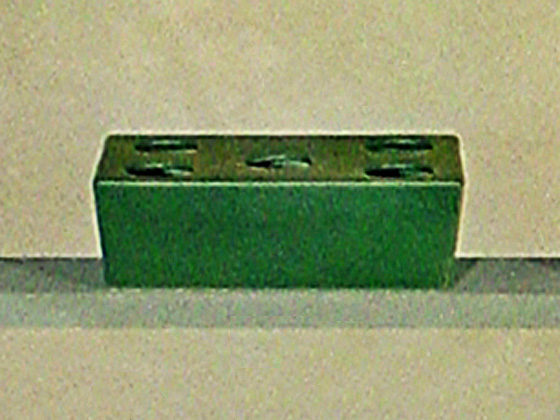
Leaf Green glaze [Photo from back cover of 1958 Fall Catalog Supplement]
RG-176 Dome
Notes: Sold with bowl RG-175, as shown.
Sources: 1962 Catalog [1]

[Amy Clay-Laney]
R-104 Deer
Sources: 1938-1940 Catalog [2]

[Susan Mathews]
Additional Examples
Click to enlarge and read annotation


R-125 Sea Gull
Sources: 1938-1940 Catalog [2]

[photo needed]
R-157-B Three Diving Sharks
Sources: 1938-1940 Catalog [2]

[Brad Hissing]
R-169-B Leaping Trout
Sources: 1941 Catalog Number 140 [1]

White, and Green Agate glazes [Jay Jalovec]
R-189 Seated Nude
Sources: 1938-1940 Catalog [2]

Peach Agate glaze with R-371 bowl [Joyce Donahue]
Additional Examples
Click to enlarge and read annotation




R-218-B Giraffes
Sources: 1938-1940 Catalog [2]

[photo needed]
R-316 Three Birds
Sources: 1941 Randall Floral Catalog [1]

Green Briar glaze [Lanette Battaglia Clarke]
Additional Examples
Click to enlarge and read annotation

R-333-B Shrouded Woman
Sources: 1941 Flower Fun Brochure [2]

Peach Agate glaze [Rick Risser]
R-359 Two Birds
Sources: 1941 Catalog Number 140 [1], 1941 Randall Floral Catalog [1], 1946 Catalog [1], 1947 Diamond Jubilee Design Catalog [1]

Mauve Agate glaze [Gerri Becker Brock]
Additional Examples
Click to enlarge and read annotation






R-360 Tropical Fish
Aliases: Twin Fish Flower Holder
Sources: 1941 Catalog Number 140 [1], 1941 Randall Floral Catalog [1], 1946 Catalog [1], 1946 Randall Floral Catalog [1], 1947 Diamond Jubilee Design Catalog [1], 1948 Randall Floral Catalog [1], 1949 Spring Catalog [1], 1950 Catalog [1], 1951 Catalog [1], 1952 Catalog (1 of 2)[1]

Mauve Agate glaze [web]
Additional Examples
Click to enlarge and read annotation








R-361 Three Birds on Branch
Aliases: Flower Holder with 3 Birds
Sources: 1941 Catalog Number 140 [1], 1941 Randall Floral Catalog [1]

[Susan Mathews]
Additional Examples
Click to enlarge and read annotation



R-362 Pan
Aliases: Ornamental Flower Holder
Sources: 1941 Randall Floral Catalog [1] (image only; no number)

Mauve Agate glaze [Susan Mathews]

[Lanette Battaglia Clarke]
R-363 Nude on Fish
Aliases: Ornamental Flower Holder, Nude of Fish Block, Nude Astride Fish Block, Nude Block
Sources: 1941 Catalog Number 140 [1], 1941 Randall Floral Catalog [1], 1943 Randall Floral Catalog [1], 1946 Catalog [1], 1946 Randall Floral Catalog [1], 1947 Diamond Jubilee Design Catalog [1], 1949 Spring Catalog [1], 1950 Catalog [1], 1951 Catalog [1], 1952 Catalog (1 of 2) [1], 1953 Spring Catalog [1], 1953 Fall Catalog [1]

Mauve Agate glaze [web]

Ebony, Tropical Briar, Green Briar, Mauve Agate, Mallow, Platinum Grey, Bone Ash (?), Ciel, Cloudy Blue, Yellow, Chartreuse, and Green Agate glazes [Jeffrey Gerard Trzeciak]
Additional Examples
Click to enlarge and read annotation








R-364 Nude with Seal
Aliases: Nude on Seal Block, Nude Figurine on Seal Block
Sources: 1941 Catalog Number 140 [1], 1941 Randall Floral Catalog [1], 1946 Catalog [1], 1947 Diamond Jubilee Design Catalog [1]

Mauve Agate glaze on left [Lorraine Clark]
Additional Examples
Click to enlarge and read annotation







R-514 Dolphin
Sources: Listed in the Numerical Index with Price Guide in Collecting Royal Haeger as R-514 - Dolphin Flower Block, 9-3/4" H.

Mallow, and Blue with White glazes [Jay Jalovec]
Additional Examples
Click to enlarge and read annotation

R-619 Nude
Sources: 1948 Randall Floral Catalog [1]

[Susan Mathews]

[Randall Stanek]
R-672 Mongolian Man
Sources: 1949 Spring Catalog [1]

Green Agate glaze [John Magon]

Man facing is Chartreuse glaze [Annie Liner]
R-673 Mongolian Woman
Sources: 1949 Spring Catalog [1]

Woman facing is Yellow glaze [Annie Liner]
R-710 Square
Sources: 1950 Catalog – Part I (no image; number is found in price list) [1]

Ebony and Green Agate glazes
Additional views and measurements of the above examples may be found here.
[Peter Christensen]
Additional Examples
Click to enlarge and read annotation


R-730 Fruits & Leaves
Notes: R-730 was also sold in a set (R-728S) including a bowl (R-728), candleholders (R-729), and flower frog (R-730). Individual items are listed in the price list.
Aliases: Oval Flower Block (oval is likely referring to the bowl it's displayed in)
Sources: 1950 Catalog – Part I (number is found in price list) [1]

Mauve Agate glaze [Gwynne Goodlett]
Additional Examples
Click to enlarge and read annotation



R-761 Hexagonal
Notes: R-761 was also sold in a set (R-727S) including a bowl (R-727), candleholders, and flower frog (R-761). Individual items are listed in the price list.
Sources: 1950 Catalog – Part I (number is found in price list) [1]

Chartreuse and Catseye glazes
Additional views and measurements of the above examples may be found here.
[Peter Christensen]
Additional Examples
Click to enlarge and read annotation

R-772 Stag
Sources: 1950 Catalog [1]

Chartreuse glaze [Barbara J. Ankenbauer]
Additional Examples
Click to enlarge and read annotation


R-788 Jockey on Race Horse
Sources: 1950 Catalog [1]

Ebony glaze [Jay Jalovec]
Additional Examples
Click to enlarge and read annotation

R-813 Round
Identification: In the 1950 catalog the R-813 Flower Block and R-792 Open Bowl you see in these examples are listed as separate pieces. However, in both of these examples the blocks came attached to the bowls.
Sources: 1950 Catalog [1], 1951 Catalog [1]

Chartreuse & Honey glaze [Shelley Galinkin]
Additional Examples
Click to enlarge and read annotation


R-820 Bird
Notes: Sold with R-819 Acanthus Leaf Bowl, as shown.
Sources: 1950 Haeger Catalog [2]

Chartreuse and Honey glaze [Barbara J. Ankenbauer]
Additional Examples
Click to enlarge and read annotation

R-836 Sitting Frog
Notes: Note the platform under the frog in the first small image, below. I am just assuming that it's a variation of the same R-836.
Sources: 1950 Catalog – Part II (no image; number is found in price list) [1]

[Lorraine Clark]
Additional Examples
Click to enlarge and read annotation









R-837 Laying Frog
Sources: 1950 Catalog – Part II (no image; number is found in price list) [1]

Chartreuse glaze [Katie Arehart-Rose]
Additional Examples
Click to enlarge and read annotation

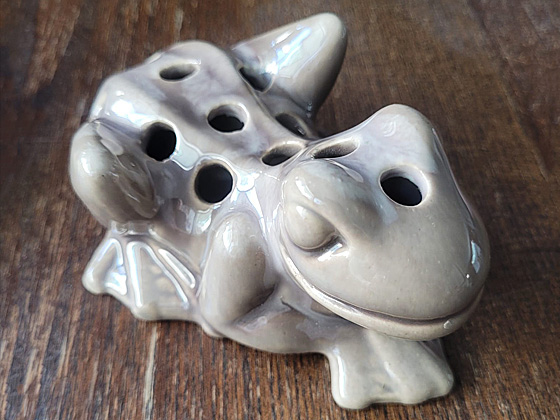




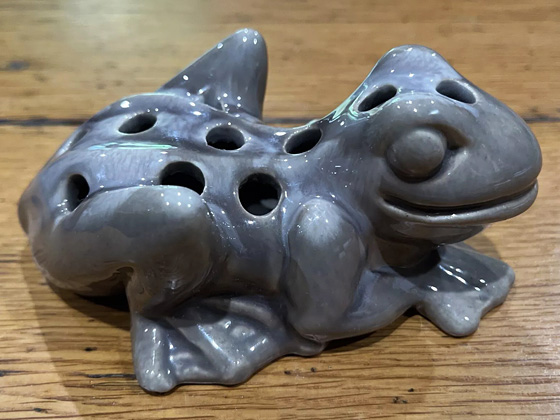

R-838 Turning Frog
Sources: 1950 Catalog – Part II (no image; number is found in price list) [1]
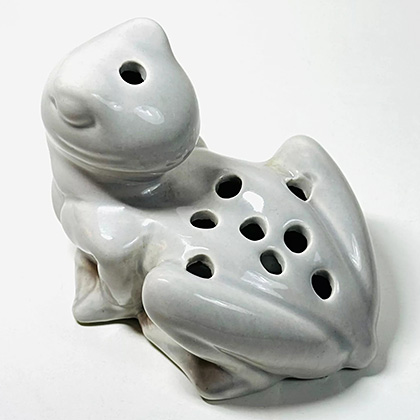
[ThreeRiversThrifters on eBay]
Additional Examples
Click to enlarge and read annotation


R-977 Shell
Sources: 1951 Catalog [1]

Green Agate, Ebony, and Chartreuse & Honey glazes [Steven Blas]
Additional Examples
Click to enlarge and read annotation




